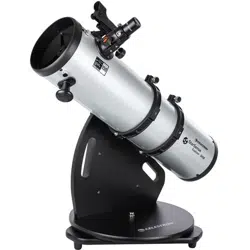Loading ...
Loading ...
Loading ...

ENGLISH I 13
COOLING YOUR
TELESCOPE’S OPTICS
You’ll get the best views through your telescope when it
has reached thermal equilibrium with the ambient air. If the
telescope is warmer than the outside air, the mirror will
acclimate to the temperature, and its fi gure will change. The
images you see through a telescope that has not cooled
will not appear as sharp as they otherwise would. If you are
taking your telescope from a heated house to the outdoors,
allow around one hour before expecting it to produce the
best images. For this reason, we recommend storing your
telescope in a dry but unheated area like a garage or storage
shed. Alternatively, take the telescope outdoors an hour
before sunset to let it acclimate to the ambient temperature.
NOTE ABOUT
SMARTPHONE POWER
Before observing with your StarSenese Explorer Tabletop
Dob, be sure your smartphone is well-charged. While
running the StarSense Explorer app, the smartphone’s
camera is constantly looking at the sky, and its processor
is continuously determining the current sky location, so it
uses signifi cant power. If your smartphone is fully charged, it
should last several hours. But if you plan to observe all night,
we recommend bringing a charger for your smartphone.
Celestron offers a handy portable charger called the
PowerTank Glow 5000, which also has a built-in red LED
fl ashlight. The SSE Tabletop Dobs have a specifi c mounting
location for the PowerTank Glow 5000, which utilizes the
connecting bands which come with the PowerTank (Figure
13a). Simply mount the PowerTank Glow 5000 onto the
base handle as shown, then connect it to your smartphone
with your charging cable while in the StarSense dock.
This will give your smartphone plenty of power for longer
observing sessions.
Figure 13a: The PowerTank Glow 5000 mounts to the cutout handle in the
base using the bands which come with the PowerTank.
YOUR FIRST NIGHT OUT
WHAT TO EXPECT
You can observe literally thousands of objects with the SSE
Tabletop Dobs:
The Moon
Observing the lunar surface is a great place to start. You’ll
see craters, maria, lacus, valleys, mountains, and other
features. The Moon is so bright that you might consider
using an optional Moon fi lter. It threads onto the bottom of
the eyepiece to dim the view. We also recommend using
higher-power eyepieces to explore the Moon up close.
Planets
The best planets to view are Jupiter, Saturn, Mars, and
Venus. A higher-power eyepiece will help bring out the
fi ne details. You’ll be able to see the rings of Saturn,
surface detail on Jupiter along with its moons, the phases
of Venus, and perhaps some surface detail on Mars if it
is near opposition (i.e., when it is closest to the Earth).
Stars and Double Stars
Stars will appear like points of light regardless of the
magnifi cation used. However, using higher magnifi cations,
a telescope can reveal a star’s color and “split” double
stars. For variable stars, see if you can detect a star’s
change in brightness over days or weeks.
Open Star Clusters
Open clusters are star groups that form together within
our Milky Way galaxy. They can be spectacular to view,
even from somewhat light-polluted skies. Astronomers
often describe star clusters as “crushed diamonds on
black velvet” in the telescope’s eyepiece. Clusters are
generally best viewed with low-power eyepieces, as
they usually require a wide fi eld of view to see the entire
cluster.
Globular Star Clusters
These tight clusters of hundreds of thousands of stars
coalesced early in our galaxy’s formation. These clusters
appear like globes of light. Your telescope can resolve
brighter clusters into individual stars in good conditions.
Most globular clusters are best viewed with a medium-
power eyepiece, as they are not nearly as wide as open
clusters, yet not bright enough for high power, either.
Nebulae
You’ll generally need to be under dark skies to see
gaseous nebulae, which appear as a faint glow around
stars. Don’t expect to see any nebulosity from urban skies
except perhaps the brightest ones, like the Orion Nebula
and Lagoon Nebula.
Galaxies
Perhaps the most fascinating of all objects to view,
galaxies are like “island universes” unto themselves. While
you can detect the brightest galaxies, like the Andromeda
Galaxy, from somewhat light-polluted skies, you’ll get the
Loading ...
Loading ...
Loading ...
